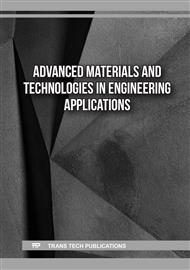[1]
H.J. Round, A note on carborundum, Electr. World 19 (1907) 309.
Google Scholar
[2]
J.I. Hwang, R. Hashimoto, S, Saito, S. Nunoue, Development of InGaN-based red LED grown on (0001) polar surface, Appl. Phys. Express 7 (2014) 071003.
DOI: 10.7567/apex.7.071003
Google Scholar
[3]
D.R. Opel, E. Hagstrom, A.K. Pace, K. Sisto, S.A.H. Ali, S. Desai, J. Swan, Light-emitting diodes: a brief review and clinical experience, J. Clin Aesthet Dermatol. 8 (2015) 36-44.
Google Scholar
[4]
P. Vashishtha, M. Ng, S.B. Shivarudraiah, J.E. Halpert, High efficiency blue and green light-emitting diodes using ruddlesden-popper inorganic mixed halide perovskites with butylammonium interlayers, Chem Mater. 31 (2019) 83-89.
DOI: 10.1021/acs.chemmater.8b02999
Google Scholar
[5]
M. Pope, H.P. Kallmann, P. Magnantem, Electroluminescence in organic materials, J. Chem. Phys. 38 (1963) 2042.
Google Scholar
[6]
C.W. Tang, S.A. Vanslyke, Organic electroluminescent diodes, Appl. Phys. Lett. 51 (1987) 913.
Google Scholar
[7]
G. Hong, X. Gan, C. Leonhardt, Z. Zhang, J. Seibert, J.M. Busch, S. Bräse, A brief history of OLEDs: emitter development and industry milestones, Adv. Matter. 33 (2021) 2005630.
DOI: 10.1002/adma.202005630
Google Scholar
[8]
O. Vyavahare, Fabrication and characterization of organic light emitting diodes for display applications, Thesis, Rochester Institute of Technology (2009).
Google Scholar
[9]
J.H. Kwon, R. Pode, High efficiency red phosphorescent organic light-emitting diodes with simple structure, S.H. Ko (Eds.), Organic Light Emitting Diode–Material, Process and Devices, IntechOpen, 2011.
DOI: 10.5772/18521
Google Scholar
[10]
J.H. Lee, C.H. Chen, P.H. Lee, H.Y. Lin, M.K. Leung, T.L. Chiu, C.F. Lin, Blue organic light-emitting diodes: current status, challenges, and future outlook, J. Mater. Chem. C 7 (2019) 5874-5888.
DOI: 10.1039/c9tc00204a
Google Scholar
[11]
B.W. D'Andrade, S.R. Forrest, White organic light-emitting devices for solid-state lighting, Adv. Mater. 16 (2004) 1585-1595.
DOI: 10.1002/adma.200400684
Google Scholar
[12]
A. Misra, P. Kumar, M.N. Kamalasanan, S. Chandra, White organic LEDs and their recent advancements, Semicond. Sci. Technol. (2006) R35-R47.
DOI: 10.1088/0268-1242/21/7/r01
Google Scholar
[13]
S.-H Cho, J.R. Oh, H.K. Park, H.K. Kim, Y.-H. Lee, J.-G. Lee, Y.R. Do, Highly efficient phosphor-converted white organic light-emitting diodes with moderate microcavity and light-recycling filters, Opt. Express 18 (2010) 1099-1104.
DOI: 10.1364/oe.18.001099
Google Scholar
[14]
Y.-L. Chang, Z.-H. Lu, White organic light-emitting diodes for solid-state lighting, J. Disp. Technol. 9 (2013) 459-468.
DOI: 10.1109/jdt.2013.2248698
Google Scholar
[15]
R. Pode, Organic light emitting diode devices: An energy efficient solid state lighting for applications, Renewable Sustainable Energy Rev. 133 (2020) 110043.
DOI: 10.1016/j.rser.2020.110043
Google Scholar
[16]
Q. Yue, W. Li, F. Kong, K. Li, Enhancing the out-coupling efficiency of organic light-emitting diodes using two-dimensional periodic nanostructures, Adv. Mater. Sci. Eng. 2012 (2012).
DOI: 10.1155/2012/985762
Google Scholar
[17]
J. Wang, W. Li, C. Wang, Improving light outcoupling efficiency for OLEDs with microlens array fabricated on transparent substrate, J. Nanomater. 2014 (2014).
DOI: 10.1155/2014/289752
Google Scholar
[18]
M.S. Ahsan, M.R. Hossain, S. Mehbuba, K.M. Sarif Islam, M.Z. Amin, I.-B. Sohn, Efficiency improvement of organic light emitting diodes (OLEDs) using micro/nano-structures, Proc. ICEEICT 2016, Dhaka Bangladesh (2016).
DOI: 10.1109/ceeict.2016.7873069
Google Scholar
[19]
A. Adhikary, M.S. Ahsan, M.M. Hossain, M.B. Hossain, S.H.S. Newaz, F. Ahmed, I.-B. Sohn, Improvement of light intensity and efficiency of n-ZnO/NiO/p-GaN heterojunction-based white light emitting diodes using micro-/nanolens array, Opt. Eng. 59 (2020) 117108.
DOI: 10.1117/1.oe.59.11.117108
Google Scholar
[20]
Y. Wang, M. Liu, J. Wang, Y. Zhang, Y. Qin, Y. Lu, Y. Chen, X. Zhang, W. Huang, Enhancing the light out-coupling efficiency of organic light-emitting devices with random corrugated structures, Thin Solid Films 732 (2021) 138791.
DOI: 10.1016/j.tsf.2021.138791
Google Scholar
[21]
T. Akter, A.I. Arafat, M.S. Ahsan, Efficiency enhancement of organic light emitting diodes (OLEDs) by micro/nano-structuring the substrate layer, Proc. ICECIT 2021 (2021).
DOI: 10.1109/icecit54077.2021.9641370
Google Scholar
[22]
D.-H Cho, J.-W Shin, C.W. Joo, J. Lee, S.K. Park, J. Moon, N.S. Cho, H. Y. Chu, J.-I. Lee, Light diffusing effects of nano and micro-structures on OLED with microcavity. Opt. Express 22 (2014) A1507.
DOI: 10.1364/oe.22.0a1507
Google Scholar
[23]
E.-J Bae, S.-W. Kang, G.-S. Choi, E.-B. Jang, D.-H Baek, B.-K Ju, Y.-W. Park, Enhanced light extraction from organic light-emitting diodes with micro-nano hybrid structure, Nanomater. 12 (2022) 1266.
DOI: 10.3390/nano12081266
Google Scholar
[24]
T. Akter, A.I. Arafat, Efficiency enhancement of organic light-emitting diodes (OLEDs) by micro/nano-structuring the substrate layer, Undergraduate Thesis, Khulna University, Bangladesh (2022).
DOI: 10.1109/icecit54077.2021.9641370
Google Scholar


